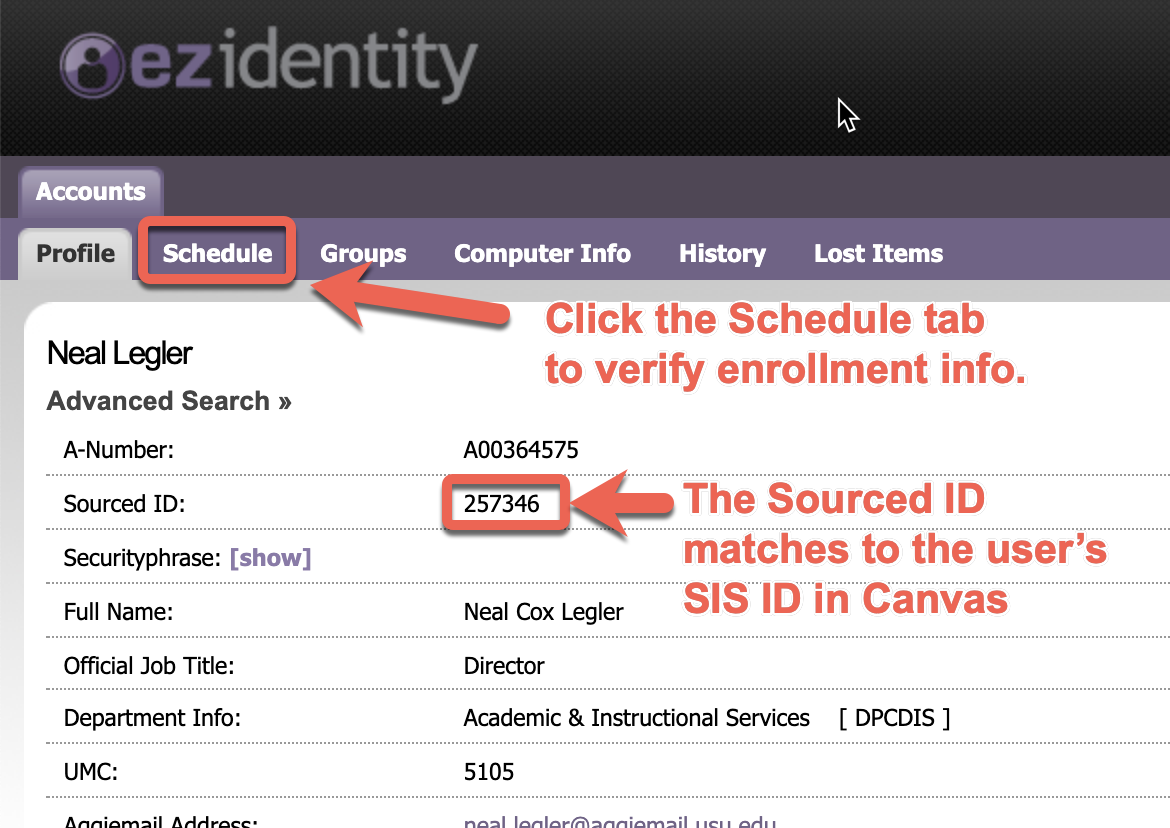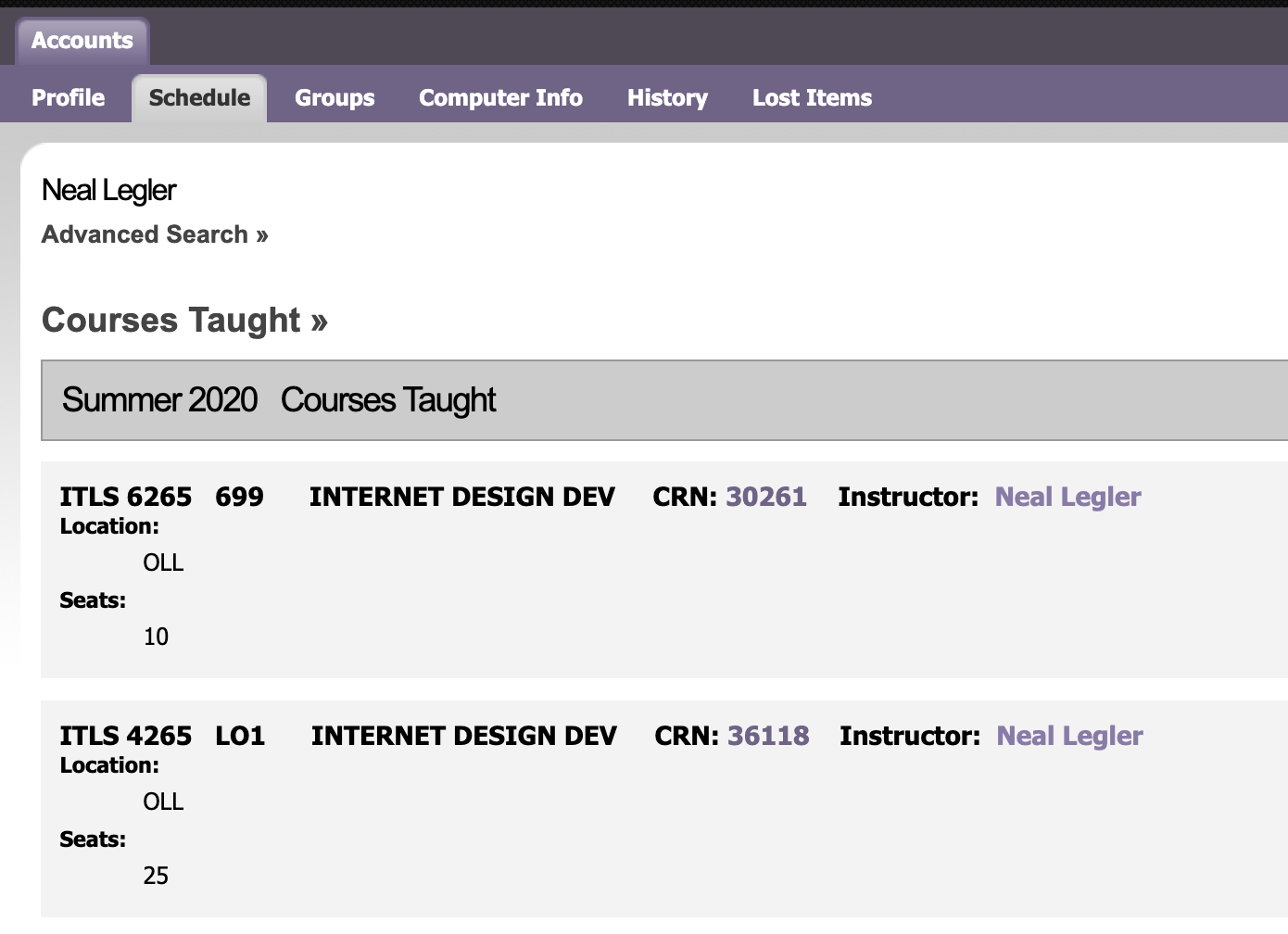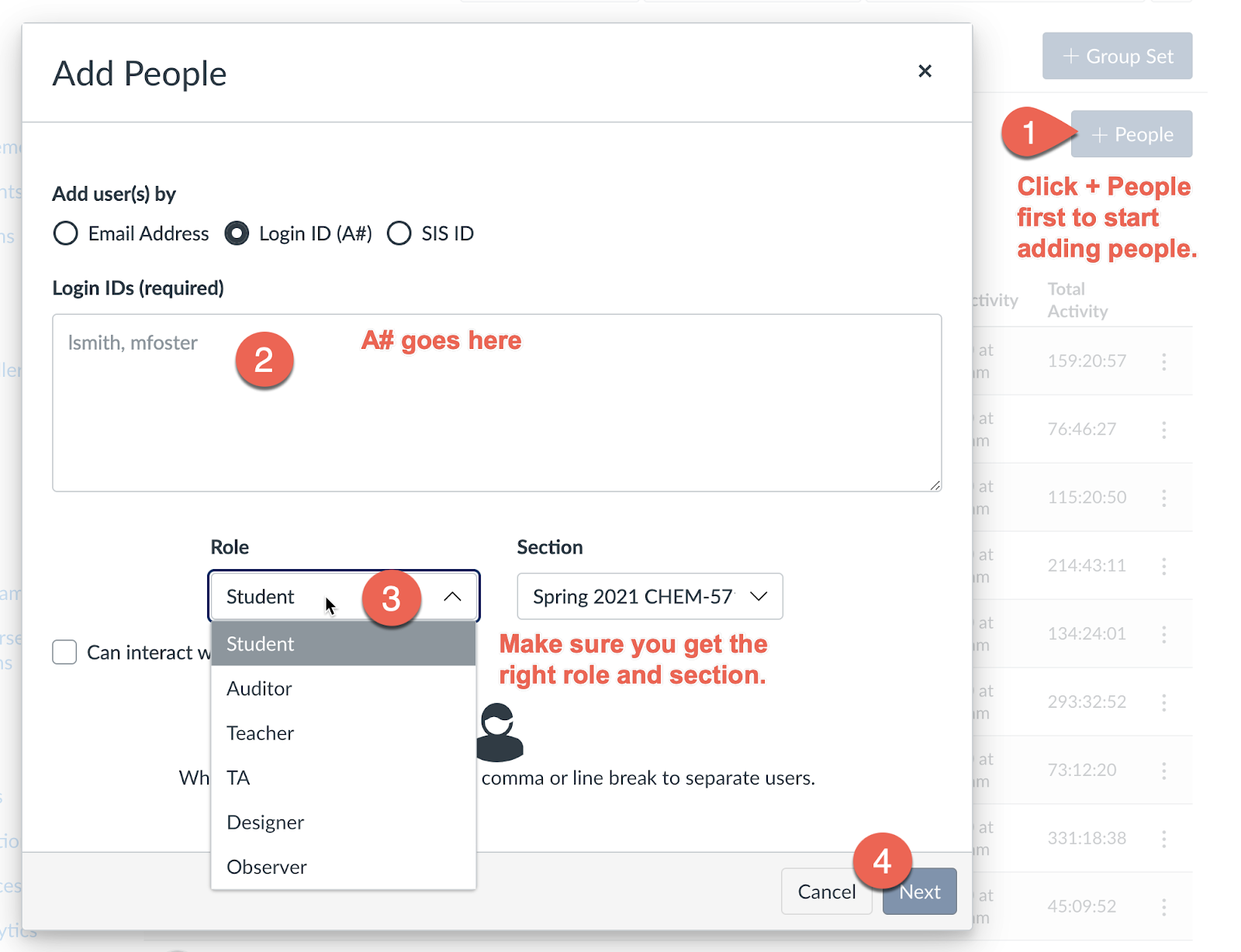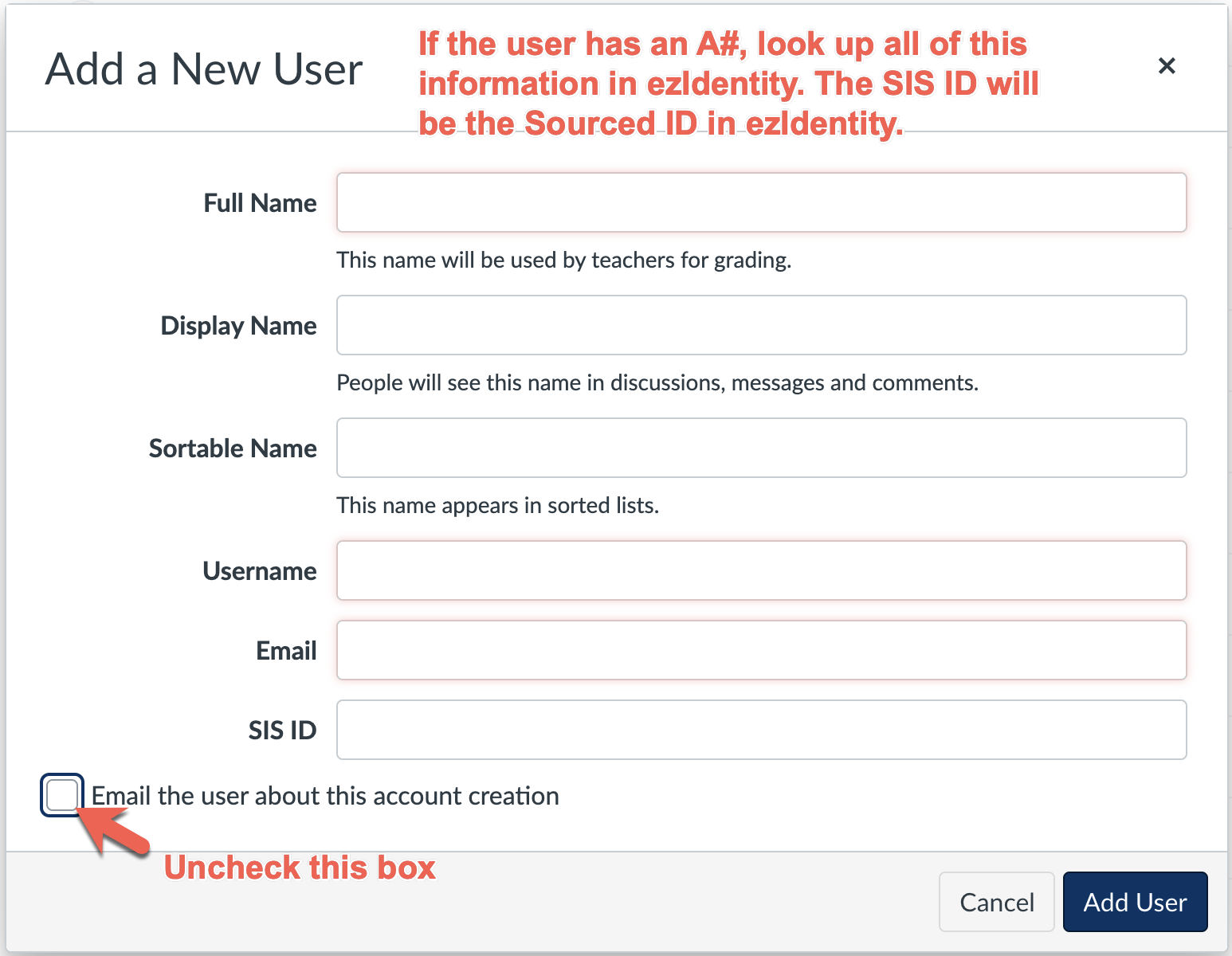10-Handling User and Enrollment Issues
Handling User and Enrollment Issues
Common user and enrollment issues include:
A user has dropped a course in Banner but hasn’t been dropped from Canvas. (Probably due to a Banner sync issue)
A teacher needs to provide extended access to a student beyond what other students get (as in the case of an incomplete grade).
But first: Looking up Banner information in ezIdentity
In the case of the first two common issues, you need the ability to check Banner information to verify that a student really is or is not enrolled in a course. This is most easily done through ezIdentity, a user and course information search tool that is connected to Banner data.
Requesting access to ezIdentity
You have to request access to ezIdentity through ServiceNow, and your supervisor has to approve. Here are the steps:
Login to the ServiceNow Service Catalog . You’ll need to login with your A# and password.
Complete the request form. Most of it will be filled already with your user information. All you really need to provide is a “description of your job function and your need for ezIdentity access.” You can type something like, “I provide Canvas support for CIDI and need to be able to check student enrollment and course scheduling information when troubleshooting issues.”
Click the Submit Now button at the top right of the screen. A notification will go to your supervisor, who will approve your request, at which point you will be given access.
Accessing ezIdentity
To access ezIdentity, your Internet connection has to be through the USU network. If you are working on campus, you are on the network already. If you are working off campus, you’ll need to use VPN to route Internet traffic through the USU network. Click here for information about VPN and how to set it up on yoru computer.
To login to ezIdentity and search for user information:
Go to https://id.usu.edu/admin and login with your A# and password.
Search for the user’s A# in the “Search by A#” field or expand the Advanced Search options and search by the user’s name, email or other identifiers.

Locate the user in the search results and click on the user record. There you can see information about the user, including the user’s A#, email addresses, and Sourced ID (which matches to the SIS ID in Canvas). You can also click on the Schedule tab to verify the user’s enrollment information for a given term.

 \
\
To access course information:
Unless you have the CRN of the course you are looking for, you’ll probably need to expand the Advanced Search options to search by the subject and course number, or by the crosslist code.

Be sure you filter by the right term.
Be sure you filter by the right term.
Look for the course in the search results and click on the course record. You will find a lot of great information in the course record, including the course start and end date according to Banner, the crosslist code (if there is one), the assigned instructor, the number of credits, and the entire course roster. Note, however, that if you are looking up a crosslisted course, you can only view the record of one section at a time--not the whole combination of crosslisted sections.
Now that you can look up information in ezIdentity, you can troubleshoot user and enrolment issues! Let’s start at the top.
User isn’t enrolled in a Canvas course but should be (allegedly).
To resolve a missing enrollment issue, you can manually enroll the course after confirming that he or she belongs in the course:
First confirm that the student should be in the class. If the student has allegedly registered for the class, look up either the course roster in Banner or the student’s account on EZ Identity (https://id.usu.edu/admin ) and see if the student is actually, officially enrolled.
If the student is enrolled, go the the People link in Canvas, click the + People button, and add the user as a student using his or her A#.

If the student is not enrolled, encourage the student to work with the teacher and/or registrar’s office to sort out the missing enrollment in Banner.
User has dropped the course in Banner but is not dropped in Canvas.
To resolve a missed “drop,” you can manually remove the student from the course after confirming that he or she should not be in the course.
First, confirm that the student shouldn’t be in the class. If the student allegedly dropped the class, look up either the course roster in Banner or the student’s account on EZ Identity (https://id.usu.edu/admin ) and see if the student has actually dropped the course.
If the student is no longer enrolled in the course, go to the People link in Canvas, click on the 3-dot menu button next to the student’s name, and choose Remove From Course.

If the student is still enrolled in the course, encourage the student to drop the course or work with the registrar’s office to be dropped from the course.
A teacher wishes to add a TA/teacher/student/auditor/observer manually.
There’s a lot of “if/then” logic to this task.
If the course is active and the teacher does not need to give the user a student role:
You can direct the teacher to go to the People link in Canvas, click the + People button, and add the user by the user’s A#. It’s best to try to walk someone through this process rather than do it yourself, so they are empowered to do it themselves next time. But if that’s proving difficult for some reason, you can do the task for them.
If the course is active and the teacher needs to give the student a user role:
It’s time for a conversation. Students usually shouldn’t be in a class unless they are officially enrolled in it in Banner. Plus, Banner, or a batch integration clean-up process, is likely to remove the rogue student enrollment in short order, anyway. That said, sometimes legitimate reasons exist. Maybe the student will soon be officially enrolled but has to take that quiz RIGHT NOW . Or maybe the department approved some random workaround to accommodate a student or a special project. If this is the case, you can keep the student from being removed in short order by, 1) creating an extra section in the Sections tab of the course, and 2) enrolling the student as an auditor instead of a student. They will probably stay put that way. But don’t make any promises, and tell the student to keep an eye out. Also note that, as of this writing, extra sections that don’t come from Banner can break the functionality to push grades from Canvas to Banner at the end of the semester. Yeah, this one’s a bit fraught.
If the course is not active:
It doesn’t really matter what role the teacher wants to provide the user if the course isn’t active any more. Anything goes that way. However, the + People button in the People section is going to be greyed out and unclickable for both the teacher and for you. What to do?
Change the end date to some date in the future (and make sure the course is going off of course rather than term settings).
The course is now reactivated and the + People button will appear. Get the A# of the user and add them to the course yourself, because you are nice and you’re going to need to do the next step before you deactivate the course again.
“Act As” the user you just added, go to the home page of the course you just added them to, and accept the invitation. (You want to do this for the user because once you deactivate the course, the user cannot do it anymore.)
Stop acting as the user, go back to the course settings, change the end date back to what it was before, and save. The course is inactive again. Access provided; balance restored.
A user account doesn’t exist in Canvas for a person who needs access.
Most of the time the user you need to give course access to is already in Canvas. But sometimes they aren’t. Why? Either the user isn’t quite fully added to Banner because employment hasn’t officially started or admission hasn’t been fully granted, or the user was inactive for a long time and his or her account was eventually deleted, or he or she isn’t associated with USU at all.
How to add a new user to Canvas
In most cases you can add a user to Canvas. Here’s how. We’ll cover exceptions shortly.
Fill out the user information box. If the user has an A#, look up the user in ezIdentity for all of the requested information. The SIS ID will be the Sourced ID for the user as it appears in ezIdentity. Be sure to uncheck the box to email the user. Then click Add User.

Exceptions
If you get an error telling you a user with the same SIS ID already exists:
Get help from one of the CIDI IDs or lead admins. This requires either an SIS import or API call to fix.
If the user is not associated with USU:
You can create an account for the user without an SIS ID. Be sure to check the box to email the user about the account creation. Make the username the user’s email address. Let the user, or the person requesting the user account, know that the user will have to go to https://elearn.usu.edu/canvas to login without an A#. He or she should receive an invitation email to set up a password. If that doesn’t work, he or she can always use the Forgot Password link on https://elearn.usu.edu/canvas to set a new password.
The user has login issues--like getting the password to work.
We cannot reset A# passwords. The user can first try resetting a password at https://myid.usu.edu . If that causes problems, he or she should contact the IT Service Desk at 435.797.HELP(4357) or use the chat feature at https://it.usu.edu .
If the user doesn’t have an A# account, he or she can go to https://elearn.usu.edu/canvas and use the Forgot Password link to get a new password. Note that the email to reset a password may go to the user’s spam folder, so they should check there.
A teacher needs to provide extended access to a specific student
This is a bit of a process. We’ll cover this in the tutorial on Incompletes.
